An Unusual Vacation in Tibet or the “Roof of the World”
Whenever it is time for a holiday, a typical question comes up – where to go? As a rule, the imagination gets exhausted rather quickly. America and South Africa – too far and expensive. Ski resorts – some time later. Southeast Asia – rainy season. Partying resorts have been visited many times… But you want to feel peace and relaxation, to meditate and take a break from the world.
I’d like to draw your attention to China. In this country you’ll be able to get to know yourself as you are, to see the ocean beneath the waves while your mind and body relax. You’ll come back home with a load of new knowledge that can be applicable in any sphere.
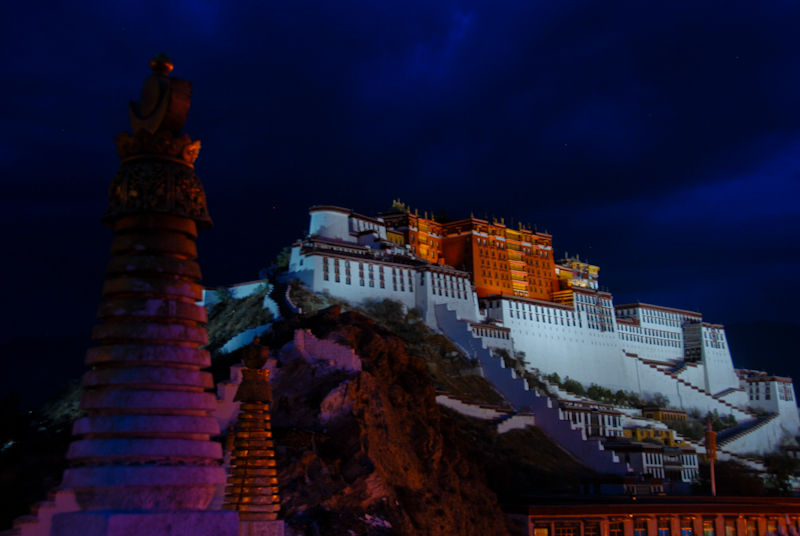
There are many things worth learning from China both in the economic and spiritual spheres. You don’t need to spend a lot of time studying Chinese hieroglyphs to read Confucius and Dèng Xiăopíng’s theory in the original version. For the first time, all you need to do is … visit China. Whilst in Urumqi or Guangzhou, you’ll see primarily production and commerce, on Hainan Island – superior service, whereas in Tibet capitalism will not strike the eye at all. Tibet with its thousand-year old Buddhist history and culture, which was affected in some respects by the Cultural Revolution, will be a real discovery for you.
There are many companies in China focused on Russian speaking tourists. Unfortunately, in Tibet Kazakh speakers will not be found, unlike in Kaxgar and Urumqi.
There are several ways to get to Lhasa – the capital of ancient Tibet. First –flying from Beijing (direct flight or a one-stop flight at Chengdu for plane change). Second – for lovers of the extreme because, in this case, you’ll have to travel two days by train in a six-seat compartment without doors and with continuously changing passengers. On the other hand, during such a trip you’ll see Mainland China not through the prism of TV news or travel shows, but directly from the inside. The train runs 2900 km to Lhasa via a 5200 m high mountain pass, upon passing which oxygen is supplied to cars. The landscapes on the way to Tibet are for the most part desert and semidesert, however, any usable piece of land is cultivated carefully. Million cities are passing by; at every turn you see buildings, bridges, plants under construction and lots of tower cranes. Coming closer to Tibet, pastures with yaks and sheep appear. As you approach Lhasa, you feel like you are entering a big, in Tibetan terms, city. Villages and managed plantations, consisting primarily of poplars, appear more frequently. And you understand what monumental efforts were applied to build such a railroad in the mountains with tunnels, bridges and overpasses. The last 1143 km road section took five years to be built and the road was opened on July 1, 2006. Along the railroad there is a good auto track.
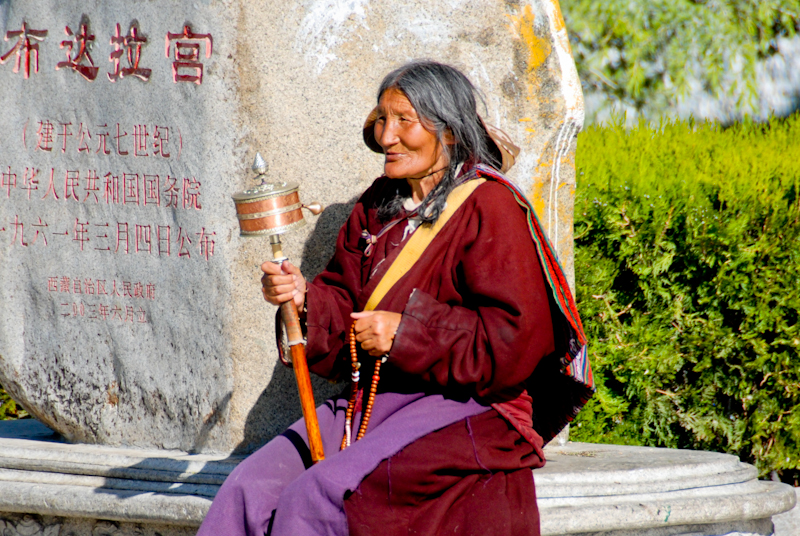
At first sight, Lhasa looks like a usual Chinese provincial town. But this impression disappears when you get to the center, where Jokhang Temple is located. This temple was built for the Nepalese princess, one of the wives of King Songtsem Gampo. In the temple there is a statue of Buddha Sakyamuni brought by the princess from the Middle Kingdom, which is considered to be one of the main Tibetan religious objects.
The temple is surrounded by the Balghor market, where you can buy original products of traditional Tibetan art such as thangkas and statues, and souvenirs. Of course, like at any oriental market, bargaining is a common practice.
The Marpo Ri hill rises in the center with the legendary Potala – the king’s palace and Buddhist temple complex – the main residence of Dalai Lama. In order to visit Potala you must register in advance at the administration – visitors are allowed to enter strictly at appointed time. One hour is given for viewing the upper palace, and video filming and photography are prohibited inside. All these measures are aimed at ensuring the protection of the ancient sight against influx of tourists.
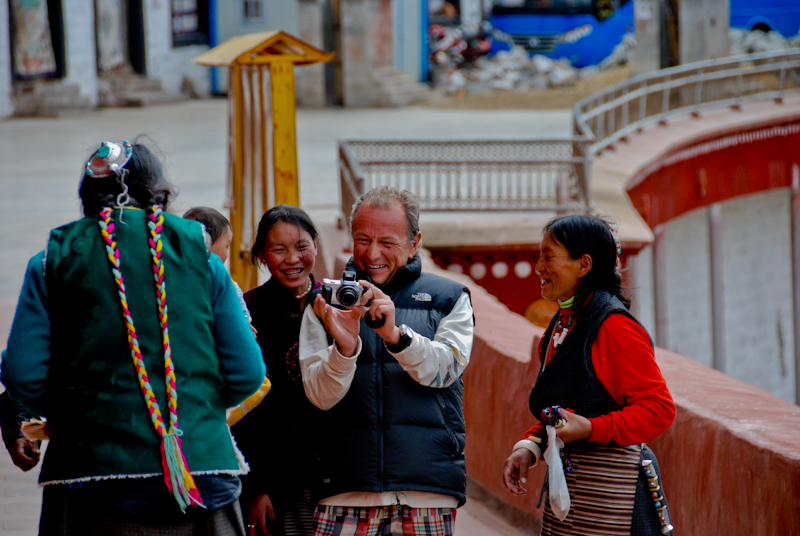
However, the main decoration of the capital are its citizens and numerous pilgrims coming to Lhasa from all Tibetan provinces, especially on the Saga Dawa holiday– a traditional Buddhist holiday devoted to birth, enlightenment and death (Parinirvāna) of Gautama Buddha. Proud long-haired warriors Khama, wild nomads from Western Tibet, women wearing ornaments made from large pieces of turquoise and corals found right on the ground in mountain regions. Many of them come to Lhasa on foot. Those whose faith is the strongest walk making prayerful bows every three steps. In Lhasa’s surroundings there are many temples and monasteries of various schools of Tibetan Buddhism. Many of them were completely destroyed during the Cultural Revolution, but since the end of the 80s, almost all of them have been restored and are currently operating. One of them – Tsurphu monastery – was previously the main residence of Karmapa, the senior Lama, who decided to undergo reincarnation deliberately for the benefit of all the living creatures after he attained enlightenment. The first Karmapa Düsum Khyenpa was born 950 years ago. The 17th Karmapa Thaye Dorje, just like the 14th Dalai LamaTenzin Gyatso, lives in India now due to political reasons.
If you want to immerse into the atmosphere of one of the most ancient religions, you can stay for a couple of days in one of the guest rooms offered by many monasteries. The monasteries’ temples are opened for visitors almost all the time. The majority of the Lamas speak Chinese, and some of them speak rather good English, so if you are a polyglot, you have a good chance to listen to Buddhist sermons right from the source.
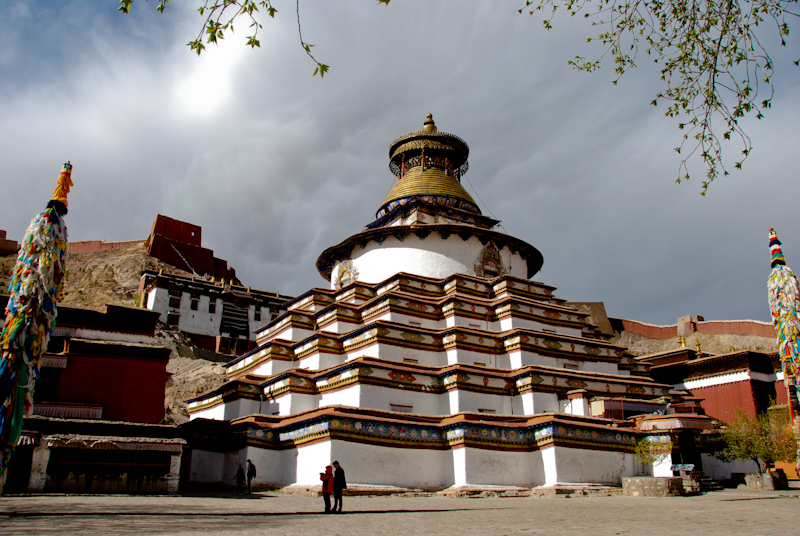
It would also be interesting to attend traditional ceremonies where the monks chant ancient texts and mantras. If you are ready to learn something new about the potential of your mind, you’ll be trained to meditate.
Having arranged your thoughts, you can think about physical health. If you trust alternative medicine, don’t miss a chance to visit the Institute of Traditional Tibetan Medicine in Lhasa. You can be diagnosed for free in the course of excursion. I think you will be surprised: the doctors do not do any exams; they determine all your diseases rather accurately by pulse, the color of skin and eyes, and even your behavior. The basis of Tibetan medicine is ayurvedic medicine, but thanks to their profound knowledge about the nature of mind, Tibetan medicine can eliminate not only the consequences of diseases but also their causes. You can also improve your health in the numerous radon and hydrosulfuric springs.
Tibet would not be called “The Roof of the World” without its geographical peculiarities. The Plateau of Tibet, the largest in the world, has an area of about 2 million sq. km and average height of 4900 m. The main natural decoration of Tibet are the highest peaks in the world, part of the Great Himalaya Range located in the southern part of the plateau with the highest peak in the world and the dream of any mountaineer – the 8848 m high Everest. The Everest is called Chomolungma in Tibet and Sagarmatha in Nepal. Chomolungma is translated from Tibetan as “Holy Mother of Life” and “Mother of Gods” from Nepalese.

In order to see the Everest you need to drive to the west of Lhasa. The Internet gives travellers scary accounts about the local roads, but their awful condition is grossly exaggerated. China invests significant amounts in the development of transport infrastructure and unpaved roads take only the tenth part of the route. The tiredness felt during the journey is connected primarily with the long distances travelled. However, the unforgettable landscapes at the window will help you get over it. Despite the good condition of the road surfaces, nobody goes over the speed limits; I haven’t seen any policemen with radars. It turned out that a certain time frame is established for passing each section of the road, which is checked at each police post, so there is no sense in exceeding speed limits. After leaving Lhasa, you’ll go to the west, cross the bridge over the Brahmaputra River (Yarlung Tsangpo in Tibetan) and then head to Kamba La pass (4800 m) where you can see the Yamdrok Lake – dwelling of the wrathful Buddha forms. This is a holy lake for Tibetans, and people are not allowed even to wash themselves there. However, the majority of the lakes in Tibet are considered to be holy. But the Chinese authorities don’t care about holiness, since the lake is the main Tibetan fish reserve. On Brahmaputra a tunnel was excavated and a hydro-electric power station was installed. Since there are no rivers flowing into the lake, there is a risk of drying up. On the way to the Everest you can visit two interesting monasteries. Pelkhor Chode monastery in Gyantse with its 325 meters tall Kumbum, which is the biggest structure of that kind in Tibet. It has 5 floors, lots of rooms, statues and altars. The word “Kumbum” means “thousand” since there is a thousand images of Buddha and bodhisattva. After Gyantse, on the way to Shigaze, the second biggest town in Tibet, you can drop into a small factory that produces “tsampa”, traditional Tibetan food. It is made from roasted barley flour. Tibetans eat tsampa with tea and yak butter adding sugar to taste. Previously, this used to be the main food product for Tibetans.
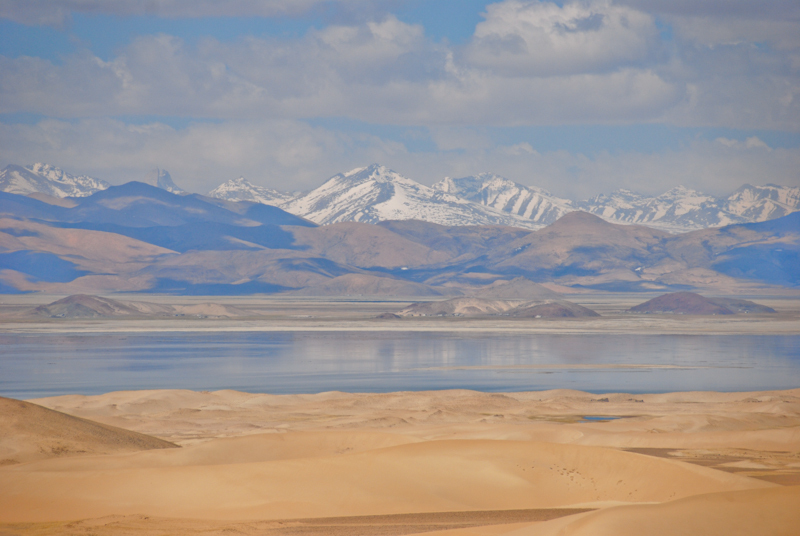
The second monastery is located in the town of Shigaze. It is called Tashi Longpo – the monastery of Panchen Lama, and was not damaged during the Cultural Revolution, in contrast to Panchen Lama. The 11th Panchen Lama recognized by Beijing – Gyaltsen Norbu – lives currently at the monastery. One of its temples has a Buddha Maitreya statue – the biggest one in Tibet. This 26-meter tall statue was made from 279 kg of gold, almost as much silver, 116 tons of bronze, over 40 diamonds and 1000 pearls.
On the way to Tibet be ready to show your permits and passport at police and military control points. If the weather conditions allow, at Gyatso La pass (5200 m) you can see the five Himalayan eight–thousand-meter peaks. The most impressive is, of course, the view of the Northern Face of Everest. When you leave the “big” towns, you’ll be able to stay overnight in guest-houses with Spartan conditions. There is only one hotel at the mountaineers’ base camp. Even at the height of 5000 meters, you’ll not feel cold thanks to eclectric blankets.
Most of the tourists come to Tibet to see the legendary Kailash Mountain, which is believed to be the center of the universe in oriental religions, and perform the three-day long ritual circumambulation “kora”. The body needs some physical activity after many days of driving. The Kora becomes eventually for many tourists the main event on their program. It is believed that the life of those who perform it will be changed for better cardinally, that they will know themselves and discover the secrets of the universe. Kailas is covered with myths and legends, crowds of esoterics go there every year.
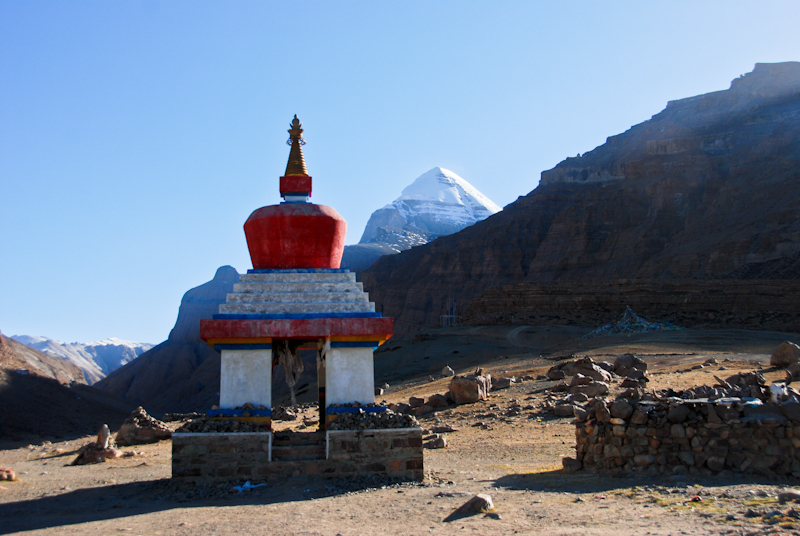
For less exalted and more practical people, a visit to Kailash is an opportunity to visit the meditation caves of the most famous ancient Tibetan yogi and poet Milarepa, whose life is an inspiring example.
The Kora starts at Darchen village and goes along the Darpoche valley passing by the western face of Kailash, which is very impressive. The Hindus believe that the god Shiva, called by Buddhists Korlo Demchog (Cakrasamvara), the senior Yidam of the Karma Kagyu school, lives on the top. On the opposite side of the valley there is the Dira Puk monastery, where one of the Milarepa’s caves is located. The second day of kora is the hardest one because tourists and pilgrims have to climb the Dolma La pass (5600 m). In good weather it is not too hard, but in case of snow, many people turn back. Most often, Hindu pilgrims, especially those from the southern states of India, turn back even in good weather because the height affects their organism harmfully. An unaccustomed organism elevated to the height of 5000 meters cannot understand what is going on and starts to function incorrectly.
In the evening you come to the neighboring valley with another monastery, Zutul Puk, and cave of the same name. On the third day, after walking 26 km, you come back to Darchen. You can spend the next night on the shore of the most famous Tibetan lake, Manosarovar. Pilgrims perform circumambulation at the lake as well, which is believed to be filled with “life-giving” water. Nearby there is another lake called Rakshas Tal, with “dead” water.
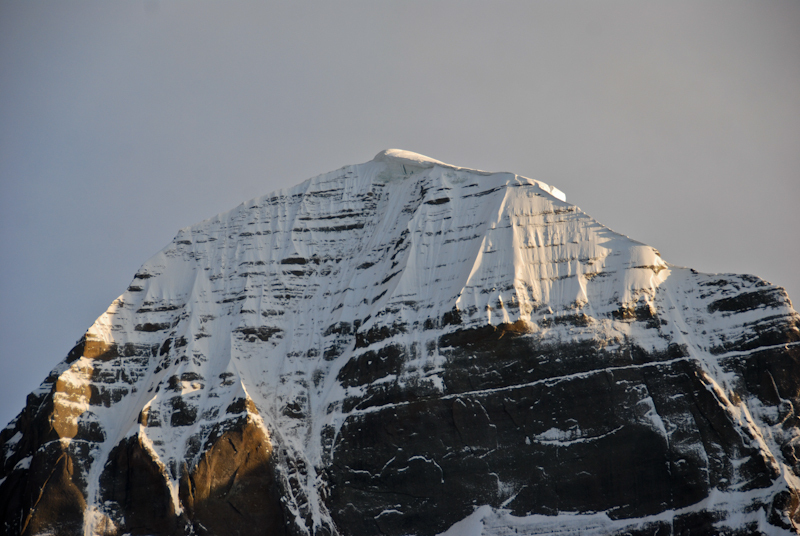
The final destination of a two-day journey is usually the Ngari province, with its ruins of the ancient kingdoms of Shanshung and Guge. These kingdoms are associated with the legendary country Shambala, the kings of which will save the progressive humanity from barbarity in the dark future. Buddhism firstly came to Tibet from the Guge kingdom.

After crossing a couple of passes and 200 km of roads under construction west of Kailash, you’ll see the sandy landscape of Toling, similar to the canyon of the Charyn River. But Toling is much larger and the rocks are not as red there. The canyon of the Sutlej River is the headwater of the Hindus. The main sight here is the cave town of Tsaparang – the capital of the kingdom of Guge – a cave complex located at the height of 300 m. On the top of it there is a small king’s palace. Communists at first destroyed everything that had not been destroyed by the Muslim Mongols who came to Guge from Ladakha, and are now restoring it actively. But, how to restore unique 5-meter tall statues with unique contents? One of the four temples in the town has several undestroyed statues. You can imagine how incredibly beautiful they were until 1966, when the ‘hóngweìbīngs’ got there. Only wall paintings were left intact. Unfortunately, taking photos is prohibited there. It is very interesting to walk in the complex, going beyond the prohibitive signs sometimes, and wondering in the labyrinth of passages from one cave to another. After seeing plenty of exotic things, be ready to travel for four day back to Lhasa. You’ll hardly want to repeat the heroic deed and go by train to Beijing. A plane will take you to the other world with the Great Wall, Peking duck, the Mausoleum of the Great Helmsman and the Temple of Heaven. But this is another story. Leaving Tibet, I felt that I had left a piece of myself there.
